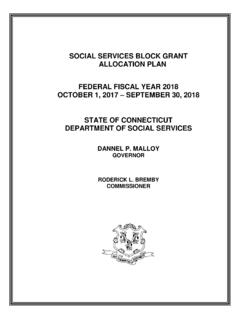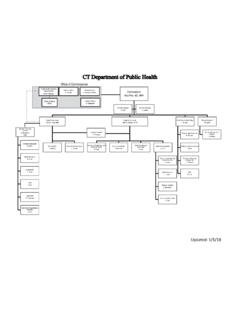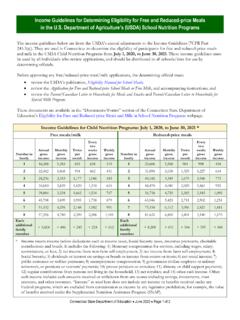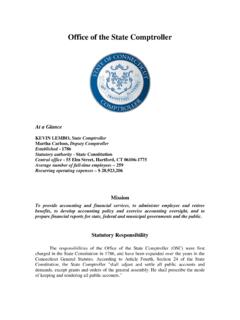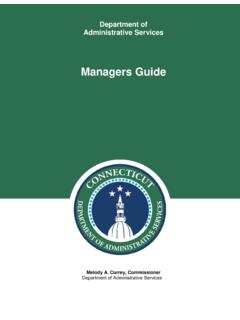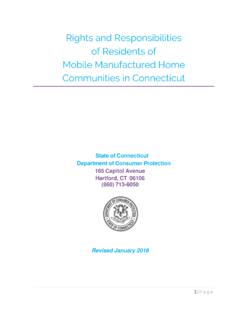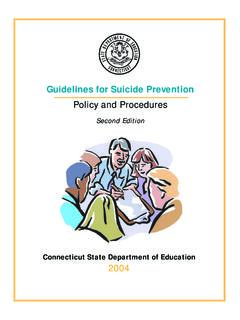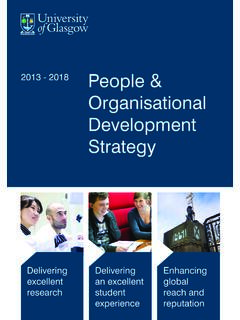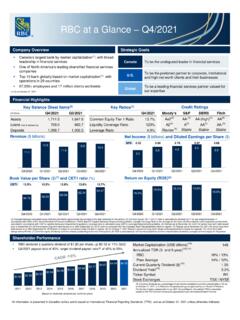Transcription of State of Connecticut | Department of Children and Families ...
1 State of Connecticut | Department of Children and Families Family First Prevention Services Act (FFPSA). Prevention plan Executive Summary Background The State of Connecticut 's child welfare system values Families and believes Children are best served safely in their own homes. A strength of the system is a fundamental belief that the wellbeing of Children and Families is a shared responsibility amongst all members of the community. When a need is identified, Families predominantly require local "support" versus government "surveillance.". Connecticut practices within an integrated child welfare structure; one which collaborates, sets priorities and supports Families remaining together. Connecticut 's Department of Children and Families (CTDCF), sister State agencies, community-based organizations, early childhood, K-12 education, healthcare, law enforcement, judicial/courts, housing, behavioral health, labor and social service systems are all on the same team, working together to achieve optimal outcomes for Children , youth, Families and communities.
2 Based on these core tenets, Connecticut welcomes the opportunity to leverage the Family First Prevention Services Act1 (Family First) to further its overarching vision for serving our Children and Families . On February 9, 2018 , Family First was signed into federal law. Family First represents a shift in federal policy as it extends the use of title IV-E funds beyond foster care and adoption assistance to prevention services intended to stabilize Families and keep them together. Specific prevention services that are newly eligible for federal reimbursement include evidence-based mental health treatment programs, substance abuse prevention and treatment programs, and in-home parenting skill-based programs rated on the Title IV-E Prevention Services Clearinghouse2. CTDCF and the State as a whole are well positioned to implement Family First in part due to the decades-long shift towards prevention and embracing Families as partners.
3 1. For a full summary of the Family First Prevention Services Act, see the Children 's Bureau's Information Memorandum, ACYF-CB-IM-18-02 available on 2. Vision: CTDCF intends to maintain its foundational mandate to keep Children safe in their Families but strives to evolve its mission, vision and strategies to become an agency that empowers Families to thrive by walking in partnership alongside them. In order to continue this evolution, CTDCF will need to rely on the collective thinking and collaborative contributions of sister agencies, providers, community partners, and most importantly on our Families to build trust and reimagine our system. Connecticut views Family First as an opportunity to continue and augment this transformation into a system of wellbeing; in part, by extending prevention services to Families earlier and continuing to realign objectives towards prevention more broadly.
4 Family First has already facilitated meaningful collaboration between partners in Connecticut to reimagine a coordinated system designed with and for Families . Along with expanding access to prevention services and fostering coalition building, one of the most exciting ways in which Connecticut intends to leverage Family First is as a tool to redefine which Families are eligible for title IV-E preventive services and the manner in which CTDCF plans to manage their cases. Connecticut developed a broad candidacy population ( Families eligible for Family First services). definition that includes two groups of candidates: 1) Those that are already "known-to-CTDCF" either through a call to the Careline, prior involvement in the system, or current involvement (pregnant and parenting youth in foster care) and;. "Known to-CTDCF" Family First Candidates Families with accepted Careline calls Siblings of youth in foster care Pregnant and parenting youth in foster care 2) Families that will be referred through a "community pathway".
5 Community Pathways Family First Candidates Families accepted for Voluntary Services (now Voluntary Care Management as of May 1, 2020). Youth that have exited foster care Children who are chronically absent from preschool/school or are truant from school Children of incarcerated parents Trafficked youth Unstably housed/homeless youth and their Families Families experiencing interpersonal violence Youth who have been referred to juvenile review boards, youth service bureaus, or another diversion program or who have been arrested Caregivers or Children who have a substance use disorder, mental health condition or disability that impacts parenting Infants born substance exposed as defined by the State 's Child Abuse Prevention and Treatment Act (CAPTA) notification protocol3. The community pathways population includes upstream Families experiencing specific behavior, conditions, or circumstances that are likely to have an adverse impact on a child's development or 3CT definition of infants born substance-exposed for the purposes of the CAPTA notification: A newborn: (1) exposed in utero to methadone, buprenorphine, prescription opioids, marijuana, prescription benzodiazepines, alcohol, other illegal/non-prescribed medication, and/or the misuse of prescription/over the counter medication; (2) with withdrawal symptoms; (3) diagnosed with Fetal Alcohol Syndrome.
6 2|. State of Connecticut | Family First Prevention plan - Executive Summary Page functioning and for whom research establishes that such characteristics or conditions place them at increased risk for maltreatment, involvement with the child welfare system, or out-of-home placement. Connecticut sees this pathway as a tremendous opportunity to provide services earlier to Families to establish stability and family well-being, and to prevent foster care entry. To engage these Families earlier, CTDCF heard directly from Families and partners Phased Approach to Candidacy that it was important to develop an entity outside of the Department to assist in accessing supports for them. Therefore, within available resources, CTDCF plans to contract with a Care Management Entity (CME) to engage these "community pathways" Families , provide assessment, manage service referrals, and monitor ongoing progress.
7 For all aspects of Connecticut 's implementation of the community pathways populations, CTDCF will require the partnerships, infrastructure, and resources be in place before contracting with the CME and serving community pathway Families . Therefore, Connecticut intends to serve these Families in its second phase of implementation, with the exception of Families accepted for Voluntary Care Management services who will be served in the initial phase. Process: To develop a sound prevention plan , the State of Connecticut Department of Children and Families led a structured and collaborative process to advance a prevention-oriented system. Transparency: CT established a Family First website: All workgroup documents and information were posted and maintained within the website. A mailbox, was established for community partners to ask questions and receive information about our planning.
8 Partnership and Engagement: CT involved over 400 unique community partners including parents and youth with lived experience, decision makers throughout State government, community organizations, advocates, and contracted providers. Shared Decision-Making: Connecticut convened a Governance committee and seven workgroups. The Governance committee, comprised of CTDCF leadership and community partners, served to review evidence and community informed recommendations from each of the workgroups. After engaging in dialogue and receiving feedback, recommendations were provided to the CTDCF Commissioner. 3|. State of Connecticut | Family First Prevention plan - Executive Summary Page The Department held focus groups with caregivers with lived experience in order to seek input on how prevention services can be delivered, and wellbeing can be achieved. Caregiver feedback was integrated into the plan and will be embedded into implementation.
9 Caregiver themes: Offer a holistic and empathetic approach, prioritize humility, honesty and integrity Provide advocacy and peer support to Families Establish a connection, before formal assessments are conducted Focus on goals and needs from the family's perspective Respect and honor the family's culture Expand respite opportunities for Families Reduce the legwork Families have to do, by making information about services widely available Deliver services and case management with a trauma-informed approach Maintain consistency for Families (regionally, across workers, etc.). Tailor services to meet Families ' particular needs Initial Prevention Services Connecticut is at the cutting edge in the establishment of a comprehensive array of empirically supported services and resources. Because of this existing strength, Connecticut intends to continue to invest in the services, resources, and supports beyond Family First prevention services in order to serve Children and Families in a holistic way.
10 Connecticut seeks to leverage Family First as a tool to expand and strengthen its service continuum, recognizing that the services on the prevention clearinghouse do not meet all the complex needs Families may have. In order to develop Connecticut 's Family First prevention service array, the Programs and Services Workgroup engaged over 100 members including model developers, sister State agencies, providers, advocates, and Families with lived expertise. This workgroup developed and implemented a rigorous process informed by implementation science to assess the services on the Prevention Services Clearinghouse, as well as programs and services not currently eligible for reimbursement. The analysis completed in partnership with the Fiscal and revenue Enhancement workgroup was passed on to the Governance Committee who made the ultimate recommendations to the CTDCF Commissioner.
